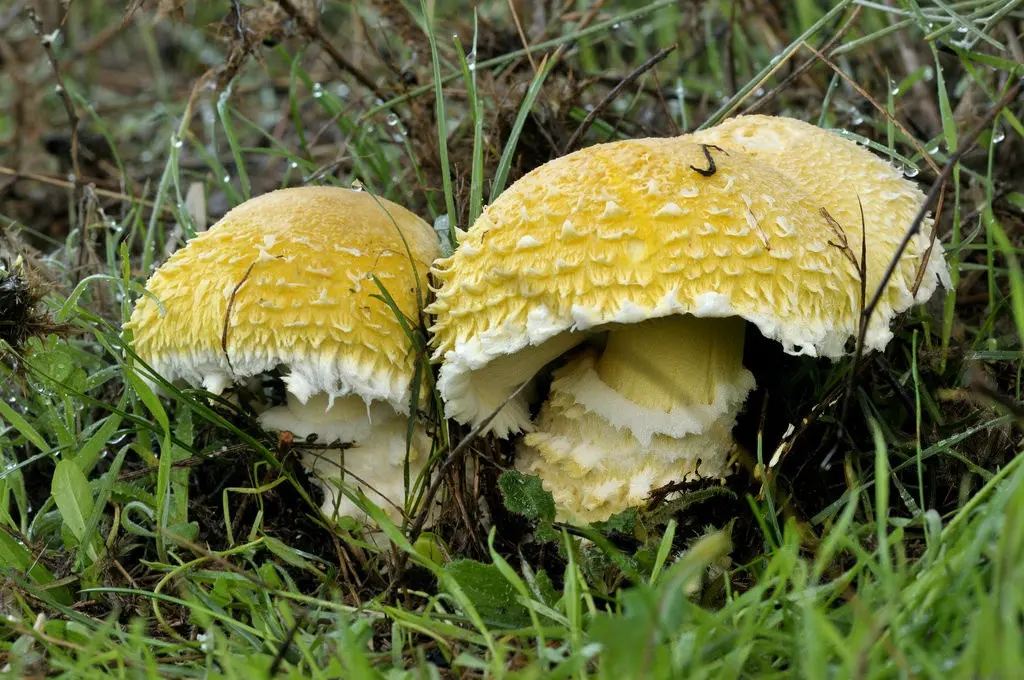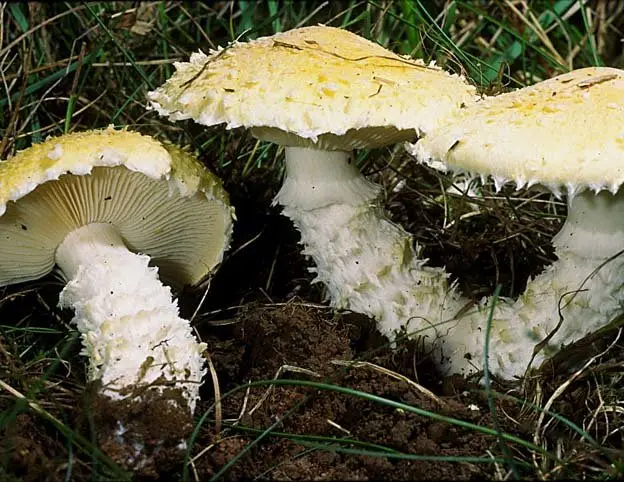Floccularia straw yellow (Floccularia straminea)
- Division: Basidiomycota (Basidiomycetes)
- Subdivision: Agaricomycotina (Agaricomycetes)
- Class: Agaricomycetes (Agaricomycetes)
- Subclass: Agaricomycetidae (Agaricomycetes)
- Order: Agaricales (Agaric or Lamellar)
- Family: Agaricaceae (Champignon)
- Genus: Floccularia (Floccularia)
- Type: Floccularia straminea (Floccularia straw yellow)

Straw yellow floccularia (Floccularia straminea) is a fungus belonging to the western variety of floccularia.
Young straw-yellow floccularia mushrooms are characterized by a bright and saturated color of the fruiting body. The entire surface of the cap and legs of this species is covered with large soft scales. Mushroom spores are starchy, and the plates are tightly attached to the surface of the fruiting body.
A hat with a diameter of 4 to 18 cm is characterized by a rounded and convex shape. However, this appearance is preserved only in young fruiting bodies. In mature mushrooms, it acquires a broadly bell-shaped, prostrate or flat, even shape. The surface of the cap of straw-yellow floccularia is dry, its cover is noticeable with tight-fitting scales. The bright yellow color of young fruiting bodies becomes noticeably paler as the mushrooms ripen, becoming straw yellow, pale yellow. On the edges of the cap, you can see the remains of a partial veil.
The hymenophore is of the lamellar type, and the plates are located very close to each other, tightly adjacent to the stem, and are characterized by yellow or pale yellow color.
The leg of the straw-yellow floccularia is characterized by a length of 4 to 12 cm, and its thickness is approximately 2.5 cm. It is more or less even in shape. Near the top of the leg is smooth, white. In the lower part, it has shaggy patches consisting of yellow fungal bedspreads of soft structure. In some fruiting bodies, you can see a flimsy ring near the cap. The color of the pulp of the mushroom is white. Spores are also characterized by a whitish (sometimes creamy) hue.
With regard to microscopic features, it can be said that the spores of straw yellow flocculia have a smooth structure, starchy and short in length.

Straw yellow floccularia (Floccularia straminea) is a mycorrhizal fungus, and can grow both singly and in large colonies. You can meet this species mainly in coniferous forests, in spruce forests and under aspens.
This type of mushroom grows near the Rocky Mountains on the western coast of Europe, and their active fruiting occurs from summer to autumn. On the West Coast, Straw Yellow Flocculia can be seen even during the winter months. This type of fungus belongs to the number of Western European species.
In addition to the Western Hemisphere, the species grows in the countries of southern and central Europe, preferring coniferous forests. Very rare or on the verge of extinction in Germany, Switzerland, Czech Republic, Italy, Spain.
Kreisel H. Global warming and mycoflora in the Baltic Region. Acta Mycol. 2006; 41(1): 79-94. argues that with global warming the boundaries of the species are shifting to the Baltic region. However, it was not possible to find confirmed finds in Poland, Lithuania, Latvia, Estonia, Leningrad region (RF), Kaliningrad region (RF), Finland, Sweden, Denmark.
So it is very important that amateurs and professionals of the mushroom world from the above countries, including Germany, as well as the countries of southern, central Europe and Eurasia in general, share their findings of the Straw Yellow Floccularia (Floccularia straminea) species on the WikiMushroom website for a detailed study of places of growth of such rare mushrooms.
Straw yellow floccularia (Floccularia straminea) is an edible mushroom, but does not have a high nutritional value due to its small size. Newcomers to the field of mushroom harvesting should generally avoid straw-yellow floccularia, as they can often be confused with some varieties of fly agaric.
Outwardly, the straminae flocculia is very similar to some types of poisonous fly agaric, so mushroom pickers (especially inexperienced ones) should be very careful when picking it.









